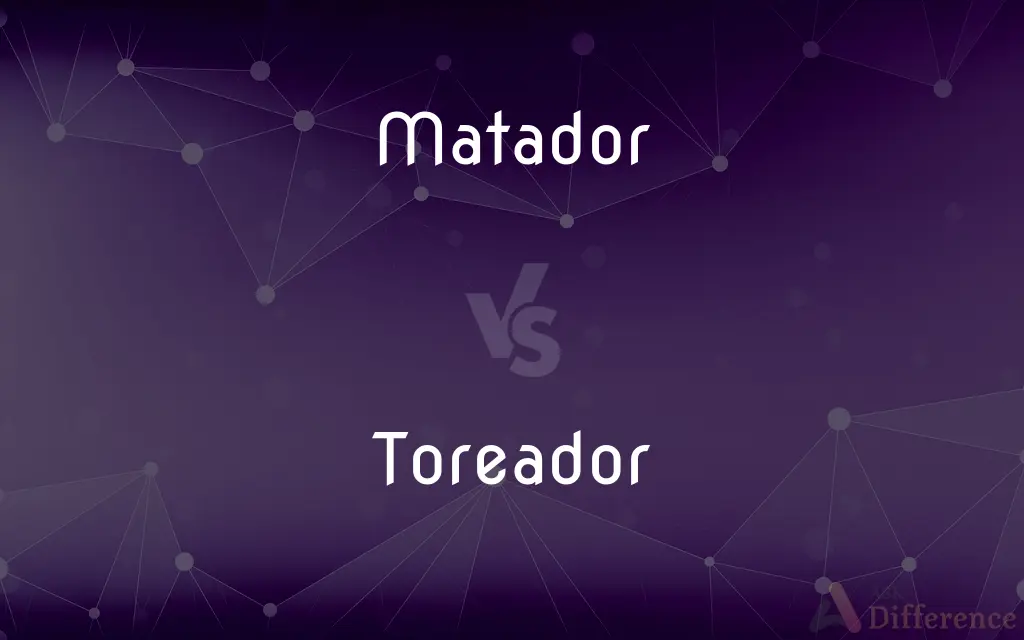Matador vs. Toreador — What's the Difference?
Edited by Tayyaba Rehman — By Maham Liaqat — Updated on February 27, 2024
A matador is the principal bullfighter who delivers the final kill, while a toreador, a term popularized by fiction, refers broadly to bullfighters.

Difference Between Matador and Toreador
Table of Contents
ADVERTISEMENT
Key Differences
The term matador, originating from the Spanish word for "killer," specifically refers to the bullfighter who performs the final act of killing the bull in a bullfight. The role of a matador is a position of high skill and prestige, as it requires not only the courage to face the bull but also the artistry to engage with it gracefully. Toreador, on the other hand, is a less specific term and not commonly used within the traditional bullfighting community. It gained popularity outside Spain, especially through works like Bizet's opera "Carmen," where the character of Escamillo is a toreador.
The matador's performance is a critical part of the event, culminating in the death of the bull, judged for both its bravery and execution. The term toreador is often used interchangeably with "bullfighter," encompassing not just the matadors but also other performers in the bullfighting event, such as banderilleros and picadors.
Matadors are celebrated for their final, decisive act against the bull, toreadors (in the broader, non-traditional sense) participate in various roles that contribute to the spectacle of the bullfight. These roles include demonstrating skill and bravery in maneuvering the bull, placing the banderillas, and preparing the bull for the final act performed by the matador.
The distinction between a matador and a toreador highlights the complexity and hierarchy within the world of bullfighting. While "matador" has a precise definition within the sport, "toreador" serves more as a cultural reference point, illustrating how bullfighting is perceived and romanticized outside its traditional context.
Despite these differences, both terms evoke the drama and danger associated with bullfighting. Whether referred to as matadors or toreadors, these figures embody the courage, artistry, and tradition that define the spectacle of bullfighting, capturing the imagination of audiences both within and beyond Spain.
ADVERTISEMENT
Comparison Chart
Definition
The principal bullfighter who kills the bull in a bullfight.
A term popularized by fiction, broadly referring to bullfighters.
Origin
Spanish, meaning "killer."
Spanish, made popular in other languages by fiction.
Role in Bullfight
Performs the final act of killing the bull.
Generally refers to any bullfighter, without specifying a role.
Skills Required
Mastery in the art of bullfighting, including the final kill.
Can refer to skills associated with any aspect of bullfighting.
Cultural Significance
Central figure in bullfighting, embodies the climax of the fight.
Romanticized image, often used in literature and opera.
Compare with Definitions
Matador
A matador is the leading bullfighter who executes the final kill.
The crowd held its breath as the matador prepared for the death blow.
Toreador
Toreador is a term often used in literature and opera to describe a bullfighter.
The toreador in Carmen is depicted as a charismatic and brave figure.
Matador
They are skilled in both the artistry and technique of bullfighting.
The matador's elegant cape work mesmerized the audience before the final act.
Toreador
It encompasses various participants in bullfighting, not just the matador.
Toreadors prepare for the bullfight with years of training in different roles.
Matador
Matadors are celebrated figures in the culture of bullfighting.
After a successful fight, the matador was carried out of the arena on the shoulders of fans.
Toreador
Toreadors are romanticized in popular culture outside Spain.
Paintings and stories often depict toreadors with a dramatic flair.
Matador
The role of a matador is highly prestigious within the bullfighting community.
Aspiring bullfighters dream of one day becoming a celebrated matador.
Toreador
The term toreador is not commonly used in contemporary bullfighting terminology.
In Spain, the term torero is preferred over toreador.
Matador
Matadors face significant risk in the bullring.
The matador narrowly escaped a dangerous charge by the bull.
Toreador
The image of a toreador has contributed to the global fascination with bullfighting.
Tourists often buy souvenirs featuring the iconic toreador figure.
Matador
A bullfighter who performs the final passes and kills the bull.
Toreador
A bullfighter.
Matador
(bullfighting) The person whose aim is to kill the bull in a bullfight.
Toreador
Someone who fights bulls
Matador
The principal bullfighter who is appointed to make the final passes and kill the bull
Common Curiosities
Is the term toreador used in Spain?
No, the term toreador is not commonly used in Spain; "torero" is the preferred term for bullfighters in general.
Can a toreador be a matador?
In the broader sense used in popular culture, a toreador can be a matador, but in traditional bullfighting terminology, they refer to different concepts.
How did the term toreador become popular?
The term toreador became popular outside Spain through works of fiction and opera, such as Bizet's "Carmen."
How does one become a matador?
One becomes a matador through years of training, starting in bullfighting schools as a novice, progressing through ranks as a novillero (novice bullfighter), and eventually being promoted to matador de toros after demonstrating exceptional skill and bravery.
What is the main difference between a matador and a toreador?
The main difference is that a matador specifically refers to the bullfighter who performs the kill, while toreador is a broader, less specific term that can refer to any bullfighter.
What role does a matador play in a bullfight?
The matador plays the central role, performing the final act of killing the bull in the climax of the bullfight.
What skills are required to become a matador?
To become a matador, one must master the art of bullfighting, including techniques of cape work, footwork, and the precise execution of the kill, along with courage and artistic flair.
Are toreadors respected in the same way as matadors within the bullfighting community?
Toreadors, as portrayed in popular culture, are respected for their romanticized image, but within the bullfighting community, matadors hold a higher position of respect due to their specific and pivotal role in the bullfight.
What cultural impact do matadors and toreadors have outside of bullfighting?
Matadors and toreadors have a significant cultural impact outside of bullfighting, symbolizing courage, artistry, and the traditional values of their respective cultures, influencing literature, music, and art globally.
Why is the matador considered a central figure in bullfighting?
The matador is considered central to bullfighting because he embodies the climax of the event through the act of killing the bull, showcasing the highest skill level and bravery within the spectacle.
Share Your Discovery

Previous Comparison
Delight vs. Pleasure
Next Comparison
Concession vs. WaiverAuthor Spotlight
Written by
Maham LiaqatEdited by
Tayyaba RehmanTayyaba Rehman is a distinguished writer, currently serving as a primary contributor to askdifference.com. As a researcher in semantics and etymology, Tayyaba's passion for the complexity of languages and their distinctions has found a perfect home on the platform. Tayyaba delves into the intricacies of language, distinguishing between commonly confused words and phrases, thereby providing clarity for readers worldwide.














































